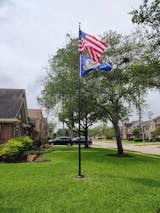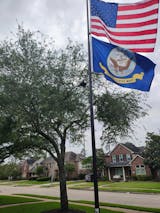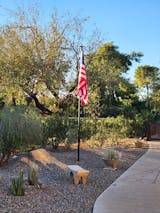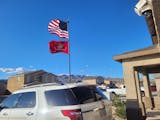HOA Flagpole Approval: Template Letters and Legal Rights for Homeowners
Want to fly the American flag at home but live in a community with HOA rules? This guide explains your legal rights under the Freedom to Display the American Flag Act, typical HOA flagpole restrictions, and proven strategies to get your flagpole approved the first time. You’ll also get ready-to-use template letters (request, follow-up, and appeal) plus practical buying advice for HOA‑friendly flagpoles—focusing on materials, finishes, lighting, and placement that protect neighborhood aesthetics and satisfy board requirements. This article is for general information and is not legal advice.
Key takeaways / summary
- Your federal right: The Freedom to Display the American Flag Act protects your right to display the U.S. flag in HOA communities. Associations may set “reasonable” time, place, and manner restrictions for safety and aesthetics—but cannot ban the flag outright.
- What HOAs often regulate: Height limits, setbacks from property lines, pole type (wall-mount vs. in-ground), finishes and colors, lighting specs, flag size/number, and noise from halyards/rigging.
- Fastest path to approval: Submit a complete package—site plan with setbacks, specs for pole/flag/lighting, wind ratings, installation method, color finish, and a maintenance plan.
- Buying advice: HOAs usually favor telescoping or wall-mounted aluminum poles in neutral, non-reflective finishes; shielded or downcast lighting; and quiet, internal lines or anti‑wrap hardware.
- Materials that pass scrutiny: Rust‑resistant aluminum, durable powder-coated finishes, and quality hardware. Choose a wind-rated pole matched to your local conditions and flag size.
- Neighbor-friendly compromises: Limit height, choose a color that blends with surroundings, specify shielded solar lighting, and use silent/low‑noise hardware. Offer a trial period.
- Where to learn more: See Atlantic Flagpole guides on what to consider before buying, lighting, and solar options.
Your rights under the Freedom to Display the American Flag Act
Before you draw a site plan or browse products, it helps to know exactly what the law protects and what it leaves to your association’s discretion. The Freedom to Display the American Flag Act (2005) says HOAs and condo associations may not adopt or enforce a policy or agreement that prevents a member from displaying the U.S. flag on residential property under the member’s exclusive use or control. At the same time, HOAs may enforce reasonable restrictions to protect the community’s interests in property values, architectural harmony, safety, and aesthetics. In practice, this means:
- They can’t ban the American flag outright.
- They can regulate the way you display it—e.g., flag size, number of flags, where a pole can be installed, whether it must be wall‑mounted, height limits, distance from property lines, and lighting details.
- Their rules should be “reasonable”—proportionate to safety/appearance concerns and consistently enforced.
Note: Some states extend protection to certain service, state, or military flags or set details about placement and flag sizes. Always review your HOA’s Covenants, Conditions, and Restrictions (CC&Rs) and any state statutes, and consider consulting a local attorney if your request is denied without clear, reasonable grounds. Observing U.S. Flag Code etiquette (including night lighting, proper condition, and half‑staff protocol) will also support your case with the Board.
Common HOA flagpole rules and what they mean for you
Most associations aim for a consistent, quiet, and safe streetscape. Expect requirements like the following, and use them to shape a proposal the board can approve on first review:
- Height: Often capped (e.g., 15–20 ft.) to match neighborhood sightlines.
- Placement/setbacks: Required distance from sidewalks, property lines, easements, and utilities; front‑yard only or wall‑mount only in some communities.
- Type: Preference for wall‑mounted brackets or telescoping poles to reduce visual clutter and simplify maintenance.
- Finish and color: Neutral, non‑reflective finishes that blend with home exteriors.
- Lighting: Downcast, shielded, or solar lighting that avoids glare and light trespass. See Lighting for Flagpoles and Solar Flagpole Light.
- Noise: Internal halyards or anti‑wrap hardware to prevent clanking lines in wind.
- Flag size/number: Limits on how many and how large (often proportionate to pole height).
- Timing: Some require dawn‑to‑dusk display unless properly illuminated at night, consistent with flag etiquette.
Tip: If your guidelines are vague, submit photos of similar, approved installations in the neighborhood to demonstrate precedent and help the committee visualize your proposal.
How to get flagpole HOA approval: a step‑by‑step plan
A polished, complete submittal reassures reviewers that you’ve considered safety, maintenance, and the look of the neighborhood. Use this sequence to keep things moving:
- Read your CC&Rs and Architectural Guidelines. Highlight sections on flag displays, exterior modifications, lighting, and landscaping.
- Call your city/county permitting office. Confirm if a building permit or utility locate is required for an in‑ground pole. In many areas, calling 811 for a utility mark‑out is required before digging.
- Choose an HOA‑friendly spec. Aluminum telescoping or wall‑mounted designs with durable finishes are commonly accepted. For help, review Atlantic Flagpole’s guide on 4 Things to Consider Before You Buy a Flagpole and Best Telescoping Flagpole.
- Draft a simple site plan. Mark your home footprint, lot lines, sidewalks, utilities, and your proposed pole location with setbacks. Include a quick photo of the location with the proposed spot marked for context.
- Assemble a complete submittal package:
- Product cut sheet/specs (height, material, finish), flag size, and wind rating.
- Installation method (ground sleeve depth, footing details, wall bracket specs). If digging, show approximate hole size and backfill/footing material.
- Lighting plan (fixture type, brightness, shielding, aiming). See Lighting for Flagpoles. Warm color temperatures (around 2700–3000K) and shielded optics reduce glare.
- Noise mitigation (internal halyard, anti‑wrap rings).
- Maintenance plan (cleaning, inspections, worn flag replacement).
- Neighbor acknowledgments (optional but helpful).
- Submit your request. Follow your HOA’s form and timeline. Keep a record of all communications.
- Follow up politely. If the review period passes with no response, send a friendly status check (template below).
- Appeal if needed. If denied, request written reasons and address them with targeted compromises.
HOA‑friendly specs: materials, finishes, lighting, and hardware
Selecting the right components shows respect for neighborhood aesthetics and makes your proposal easy to approve. Emphasize quality, safety, and quiet operation:
- Material: Rust‑resistant, architectural‑grade aluminum is the HOA standard thanks to strength‑to‑weight ratio, clean appearance, and durability.
- Finish: Powder‑coated neutral tones (bronze, black, or satin aluminum) that match roof or trim colors. Non‑reflective finishes help with glare control and look refined at curbside.
- Design: Telescoping poles lower for storms or maintenance and reduce visual bulk. Internal locking mechanisms eliminate external ropes for a cleaner look.
- Wind rating: Match your local wind zone and flag size; right‑sizing avoids leaning, excessive flex, and premature wear. If you plan to fly larger flags occasionally, size the pole accordingly.
- Lighting: Choose shielded, downcast beams or integrated solar options to comply with dark‑sky norms and avoid light trespass. Learn more in Solar Flagpole Light. A subtle, focused beam is usually preferred by HOAs.
- Hardware: Internal halyard or anti‑wrap systems with quiet swivels; stainless or weather‑resistant fittings that won’t corrode or rattle in wind.
- Flag size: Follow accepted ratios (e.g., a 3x5 ft flag for ~20 ft poles), consistent with flag etiquette and aesthetics.
For additional component guidance, see Atlantic Flagpole’s deep dives on what to consider before you buy and flag pole toppers.
Template: HOA flagpole approval request letter
Copy, paste, and customize the following. Submit it with your site plan, product specs, and lighting details.
Subject: Architectural Review Request – Residential Flagpole Installation (American Flag) Dear [Architectural Review Committee/Board Name], I am requesting approval to install a residential flagpole for displaying the United States flag at my property: [Your Name] [Property Address] [Lot/Unit Number] [Email] | [Phone] Scope of Work: • Flagpole: [Height] [Telescoping/Wall-Mounted] aluminum pole, [Finish/Color], wind-rated for our area. • Flag: [Dimensions], nylon/polyester, displayed per U.S. Flag Code. If flown overnight, it will be illuminated per guidelines. • Location: See attached site plan showing setbacks from property lines, sidewalks, easements, and utilities. • Installation: [In-ground sleeve depth/foundation OR wall bracket specs], performed by [Licensed Installer/Owner] in accordance with manufacturer recommendations and applicable codes. • Lighting: [Shielded/downcast/solar] fixture aimed to prevent glare or light trespass. Specs and beam diagram attached. • Noise Mitigation: [Internal halyard/anti-wrap system], minimizing sound during wind events. • Maintenance: I will inspect hardware regularly and replace worn flags promptly to maintain appearance. Compliance and Considerations: • This installation complies with the Freedom to Display the American Flag Act (2005). I understand the HOA may apply reasonable time, place, and manner restrictions and believe this proposal satisfies aesthetic and safety objectives. • I am open to reasonable compromises (height adjustments, color matching, alternative placement, or fixture shielding) if the Committee prefers. Attachments: 1. Product specification sheet(s) 2. Site plan with dimensions and setbacks 3. Lighting cut sheets and aiming notes 4. (Optional) Neighbor acknowledgment letters Thank you for your consideration. Please let me know if any further information is needed. I appreciate your guidance and look forward to your decision. Sincerely, [Your Name]
Template: Polite follow‑up email (if the review window passes)
Subject: Status Check – Architectural Request for Flagpole (Submitted [Date]) Hello [Name/Committee], I’m checking on the status of my flagpole request submitted on [Date]. I’ve attached the package again for convenience (specs, site plan, and lighting details). If anything else would help your review—alternate pole finish, slightly different location, or a shielded lighting option—I’m glad to provide it. Thank you for your time and for volunteering on the Committee. Best regards, [Your Name] [Address] | [Phone]
Template: Appeal letter (if denied)
Subject: Appeal – Flagpole Request for [Address] Dear Board Members, Thank you for reviewing my original request. I respectfully appeal the denial dated [Date]. The decision cites [Reason(s), e.g., “visibility from street” and “lighting concerns”]. I propose the following adjustments to address these concerns: 1) Height and Finish: Reduce pole height from [X] ft to [Y] ft and use a [matte/neutral] finish to minimize visibility and glare. 2) Placement: Move the location [distance] to increase setback and align with landscape screening, per annotated site plan. 3) Lighting: Use a shielded, downcast [solar/electric] fixture with limited lumen output and no uplight, as shown in the attached spec. 4) Noise: Confirm internal halyard/anti-wrap rigging to reduce any sound in wind. The Freedom to Display the American Flag Act protects my right to display the U.S. flag, while allowing the HOA to enforce reasonable restrictions. I believe these changes satisfy the aesthetic and safety concerns outlined while honoring federal protections. I appreciate your consideration and would welcome a brief meeting to finalize a solution. Sincerely, [Your Name] [Address] | [Phone]
Negotiation strategies that work with HOAs
Most boards respond well to good‑faith collaboration. If your first proposal isn’t approved as‑is, these adjustments often resolve concerns:
- Offer a slightly shorter pole or a wall‑mounted bracket to reduce visual impact.
- Match the pole finish to roof, trim, or fencing colors for cohesion.
- Use shielded, downcast lighting (or solar with integrated diffusers) to prevent glare.
- Choose a telescoping design so the pole can be lowered during storms or special circumstances.
- Commit to quiet hardware (internal halyard/anti‑wrap rings) and include it in your submittal.
- Propose a “trial period” with review in 90 days; Boards often appreciate cooperative good faith.
- Plant low landscaping around the base to screen the footing and integrate the installation.
Flag etiquette and compliance your HOA will appreciate
Following etiquette not only honors the flag—it also demonstrates care and reduces complaints. Keep these best practices in mind:
- Fly the U.S. flag in good condition; replace faded or tattered flags promptly. See Flags For Flag Poles.
- Display sunrise to sunset, or provide proper illumination for night display. See Lighting for Flagpoles.
- On inclement days, lower or secure the flag unless you have an all‑weather flag designed for such conditions.
Buying checklist for HOA‑friendly flagpoles
Even if your HOA allows flagpoles, the right spec makes approval easier and ownership simpler. Use this checklist while you compare options:
- Height: Choose a height proportionate to your house and common neighborhood limits.
- Material: Aluminum for strength, low maintenance, and clean lines.
- Finish: Non‑reflective, neutral powder coat (e.g., bronze/dark tones) to blend with surroundings.
- Design: Telescoping or wall-mounted for minimal visual impact and quiet operation.
- Foundation/bracket: Confirm appropriate sleeve depth or rated wall bracket with proper fasteners.
- Lighting: Downlight only; avoid spillover onto neighbor windows or the street.
- Wind rating: Sized for your local wind zone and intended flag size.
- Maintenance: Availability of replacement parts and ease of lowering (telescoping) for upkeep.
- Support: Note warranty terms and access to replacement components to keep the installation looking its best.
For deeper research, browse Atlantic Flagpole’s related guides:
- Best Telescoping Flagpole
- 4 Things To Consider Before You Buy a Flagpole
- Lighting For Flagpoles
- Solar Flagpole Light
- Flag Pole Topper
Inspiration gallery: HOA‑friendly installations
The following real‑world installations highlight neutral finishes, compact footprints, and neat landscaping—ideas your HOA will likely appreciate. Click any image to open a related Atlantic Flagpole article.
Troubleshooting denials: how to respond to common objections
If you receive a denial, ask for the specific provisions relied upon, then tailor your response. Here are practical ways to address typical concerns:
- “Too tall/visible.” Reduce height, switch to telescoping, or move to a less prominent location with landscape screening.
- “Lighting will cause glare.” Present a shielded, downcast fixture with beam angles and show the cone stays on your property line.
- “Noise from halyards.” Specify internal halyard or anti‑wrap rings; confirm no external clips will clank.
- “Clashes with community aesthetics.” Match color to common exterior elements, submit photos of similar installations, and reference consistent approvals.
- “Maintenance concerns.” Commit to a yearly inspection, replacement flags, and a tidy base (mulch/stone ring).
Board‑friendly submittal checklist (printable)
Use this quick list while assembling your packet to reduce back‑and‑forth and speed up approval:
- Completed HOA architectural form with contact info
- Site plan with measurements and setbacks
- Product specs: height, material, finish, wind rating, flag size
- Installation details: footing/bracket, installer info, utility locate
- Lighting specs: fixture type, shielding, aiming notes
- Noise mitigation: internal halyard/anti‑wrap system
- Maintenance plan and neighbor acknowledgments (optional)
- References to federal law and state/local code, as applicable
Frequently asked questions
Can my HOA ban the American flag?
No. Under the Freedom to Display the American Flag Act, HOAs cannot prohibit displaying the U.S. flag, but they may enforce reasonable restrictions on how it’s displayed.
What if my HOA only allows wall‑mounted flags?
Ask for a wall‑mount approval with a clean bracket and shielded lighting as a first step. Later, you may request an in‑ground pole with a documented track record of compliant display.
Do I need a permit?
Some jurisdictions require permits for in‑ground poles over certain heights. Call your local building department before you submit to the HOA, and include the permit note in your submittal.
How tall should a residential pole be?
Choose a height that’s proportionate to your home and consistent with neighborhood norms. Many communities favor modest heights that align with single‑story rooflines.
What if my HOA delays a decision?
Check your CC&Rs for review timelines and meeting schedules. A courteous, documented follow‑up (see the template above) keeps the process moving and shows you’re cooperating.
Can the HOA limit the size of my flag?
Yes, HOAs often set reasonable size limits to match pole height and aesthetics. Proposing a standard 4x6 ft flag on a ~20 ft pole is commonly accepted.
Next steps
With a clear understanding of your rights and a thoughtful, well‑documented plan, most flagpole requests are approved on the first pass. Gather your documents, choose an HOA‑friendly spec, and submit a complete package. For more practical tips and component guidance, read these Atlantic Flagpole resources:
















